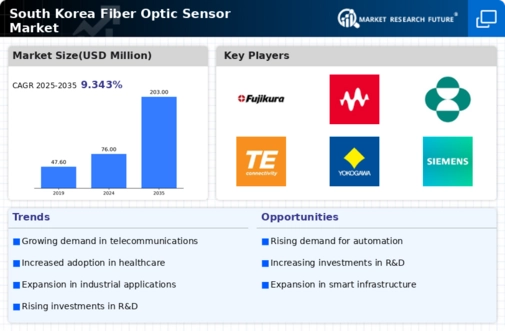Growth in Smart City Initiatives
The fiber optic-sensor market is significantly influenced by the growth of smart city initiatives across South Korea. Urban areas are increasingly adopting smart technologies to improve infrastructure, enhance public safety, and optimize resource management. Fiber optic sensors are integral to these developments, providing real-time data for traffic management, environmental monitoring, and energy efficiency. The South Korean government has allocated substantial funding, estimated at $1 billion, to support smart city projects, which is likely to create a favorable environment for the fiber optic-sensor market. As cities evolve into smart ecosystems, the demand for advanced sensing technologies is expected to rise, further driving market growth.
Advancements in Sensing Technologies
The fiber optic-sensor market is propelled by advancements in sensing technologies that enhance the capabilities and applications of fiber optic sensors. Innovations such as distributed sensing and improved signal processing techniques are expanding the potential uses of these sensors in various sectors, including telecommunications, healthcare, and environmental monitoring. In South Korea, research institutions and companies are collaborating to develop next-generation fiber optic sensors that offer higher sensitivity and accuracy. This focus on innovation is expected to drive market growth, with projections indicating a potential increase in market size by 20% over the next five years. As industries seek more efficient and reliable sensing solutions, the fiber optic-sensor market is likely to thrive.
Increased Focus on Industrial Automation
The fiber optic-sensor market is benefiting from the heightened focus on industrial automation in South Korea. As industries strive for greater efficiency and productivity, the integration of fiber optic sensors into manufacturing processes is becoming more prevalent. These sensors offer advantages such as high precision, resistance to electromagnetic interference, and the ability to operate in harsh environments. The South Korean manufacturing sector, which contributes approximately 30% to the national GDP, is increasingly adopting automation technologies, thereby creating a substantial market for fiber optic sensors. This trend is anticipated to propel the market forward, with an expected growth rate of around 12% annually over the next few years.
Rising Demand for High-Speed Communication
The fiber optic-sensor market is experiencing a notable surge in demand driven by the increasing need for high-speed communication networks. As South Korea continues to enhance its digital infrastructure, the deployment of fiber optic sensors becomes essential for ensuring efficient data transmission. The government has invested heavily in expanding broadband access, with a target of achieving 100% coverage by 2025. This initiative is expected to propel the fiber optic-sensor market, as these sensors play a critical role in monitoring network performance and reliability. Furthermore, the market is projected to grow at a CAGR of approximately 15% over the next five years, indicating a robust expansion fueled by technological advancements in communication systems.
Emerging Applications in Structural Health Monitoring
The fiber optic-sensor market is witnessing growth due to emerging applications in structural health monitoring (SHM). In South Korea, infrastructure such as bridges, tunnels, and buildings requires continuous monitoring to ensure safety and longevity. Fiber optic sensors provide a reliable solution for detecting structural changes and potential failures. The government has recognized the importance of infrastructure safety, leading to increased investments in SHM technologies. With an estimated market value of $500 million for SHM solutions by 2027, the fiber optic-sensor market is poised to benefit from this trend. The ability of these sensors to provide real-time data enhances decision-making processes related to maintenance and safety.
















Leave a Comment